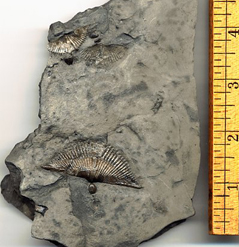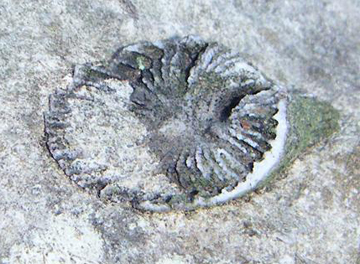Frozen in time at Cascadilla Falls
Geologic Formation:
This Earthcache is located at Cascadilla Falls Park, where you
will find a trail leading from downtown Ithaca to Collegetown on
the hilltop above. The trail follows the stream, which carved out a
gorge along this hillside. Over time, the water cut through bedrock
to expose the Late Devonian shales and siltstone layers of rock,
revealing fossils.
Fossils are the preserved traces (like footprints) of animals,
plants and other organisms. The fossils you’ll find in Ithaca date
from the Ordovician to the Late Devonian Period. They are the
imprints of ancient animals that were buried in mud and sand in a
warm shallow sea that covered this area of New York between 450 and
360 million years ago. Below you will find a list of the most
common types of fossils found here.
Brachiopods are the most common fossils in the area.
Brachiopods have two shells, and look a little like clams, but they
are actually very different kinds of animals. The fossils are
small, usually less than 2” across. Brachiopods are still alive in
oceans today but are much less common than they once were.

Trilobites are one of the most well-recognized fossils.
They are now extinct, but are related to living horseshoe crabs and
lobsters. Their segmented bodies look a little like pill bugs. Two
kinds of trilobites are frequently found in rocks around Ithaca,
and one is especially common. It is rare to find whole trilobites
because most fossils are of the broken molted skins of growing
trilobites.

Corals come in two kinds among the Devonian fossils of
Ithaca: Rugosa or "horn" corals, and tabulate or "honeycomb"
corals. Both of these kinds of corals are extinct, but they
resemble modern corals in some ways.

Crinoids (sometimes called "sea lilies") are not plants
but are relatives of starfish and sea urchins. They have a
multi-armed head on a long, flexible stalk made of many discs. The
discs are often preserved as fossils.

Cephalopods are mollusks and today include squids,
octopus and the chambered nautilus. Fossils of two kinds of
cephalopods can be found in the rocks around Ithaca. Both have
straight or coiled shells divided into separate chambers.
Nautiloids have simple curved walls separating these chambers;
ammonoids have more complex walls.

To Log this Earthcache you need to complete the following
task:
- Find a fossil in Cascadilla Park, and take a picture of it with
your GPS.
- In your log, post your photo and identify the type of fossil
you found.
Sources:
Finger Lakes Geology
visit
link
Geology of New York, Y.W. Isachen, E. Landing, J.M. Lauber, L.V.
Rickard, W.B. Rogers, editors
Fossil Guy visit link
Overview of New York Geology
visit link
Geological Sciences 101
visit link
Sedimentary Rock
visit
link
Museum of the Earth at PRI